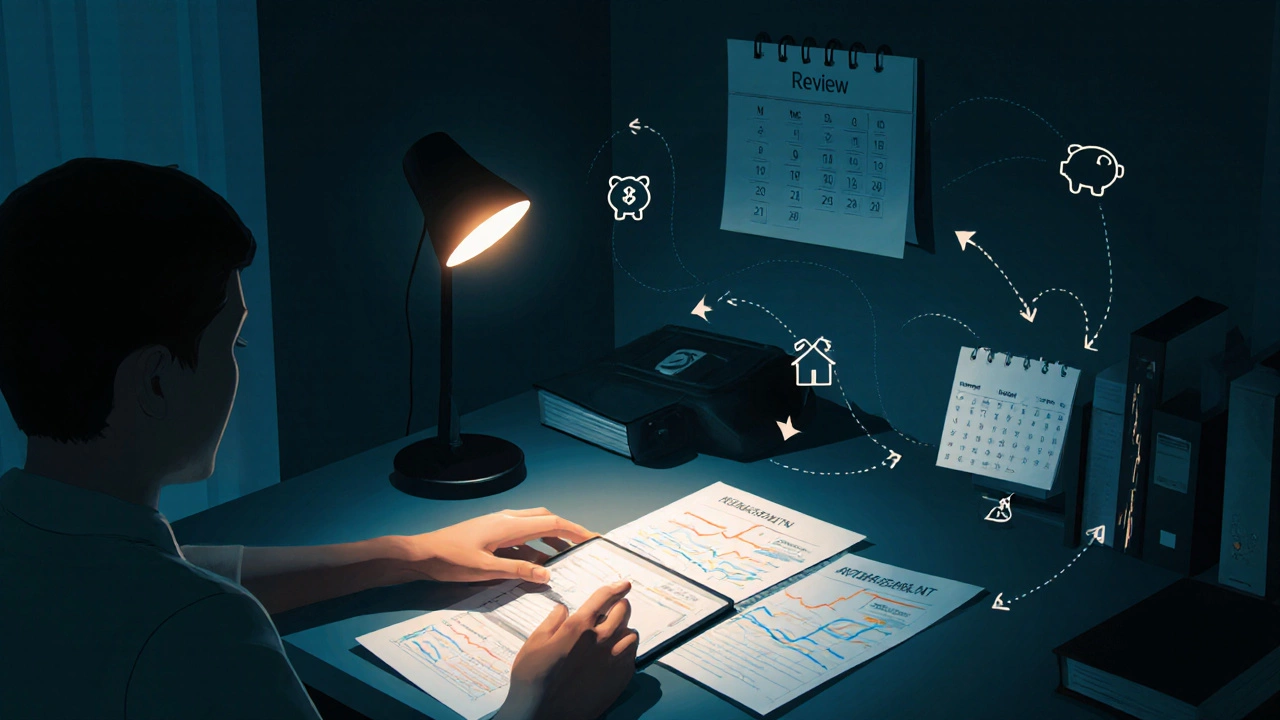Emergency Fund Calculator
Build Your Financial Safety Net
Based on the Reserve component of the 3 R's budgeting framework, calculate your ideal emergency fund target and track your progress.
Your Emergency Fund Target
Based on the Reserve component of the 3 R's framework:
- 3 Months £
- 6 Months £
Your Progress
At your current savings rate:
Key Takeaway
The Reserve component of the 3 R's framework helps you build a financial safety net that protects you from unexpected events. Consistent monthly savings makes this achievable.
When your budget is a plan that matches your income with your spending goals, you gain control over every pound you earn, you stop feeling like money is slipping through your fingers. The secret isn’t a fancy spreadsheet or a pricey app; it’s a simple framework called the 3 R's. By breaking budgeting down into Reality, Reserve, and Review, you can build a habit that sticks, even when life throws curveballs.
What the 3 R's Actually Mean
The 3 R's are a step‑by‑step mental model that keeps your budget realistic, protected, and adaptable. Think of them as three pillars you check every month:
- Reality - Get a crystal‑clear picture of what’s coming in and what’s going out.
- Reserve - Set aside money for emergencies and predictable irregular expenses.
- Review - Track, evaluate, and tweak your plan based on what actually happened.
This trio works for anyone-from a student juggling a part‑time job to a retiree managing a pension. Below we unpack each R with concrete actions, real‑world examples, and tools that make the process painless.
R1 - Reality: Know Your Income and Expenses
Before you can tweak anything, you need an honest snapshot of your cash flow. Most people underestimate how much they spend on “little things,” and those hidden costs add up fast.
Cash Flow is the movement of money into and out of your accounts over a set period is the metric you’ll watch closely. Here’s how to get it right:
- Gather all income sources - salary, freelance gigs, benefits, interest, and any side‑hustle earnings.
- Track every expense for a month - use a spreadsheet, a notebook, or an expense‑tracking app like Expense Tracking App software that automatically categorises and visualises spending.
- Categorise consistently - group spend into fixed (rent, utilities) and variable (groceries, entertainment).
When you add up the numbers, you’ll see the true gap between what you earn and what you spend. If expenses exceed income, you now have the data you need to cut back in the right places.
R2 - Reserve: Build a Financial Safety Net
Reality tells you where you stand; Reserve protects you from falling off the edge. An emergency fund is the cornerstone of a resilient budget.
The rule of thumb is to keep three to six months' worth of essential costs in a highly liquid account. But “essential” can vary. For a single renter, it might be rent, utilities, and food. For a family with a mortgage, it could include mortgage payments and child‑care costs.
Here’s how to set up a robust Reserve:
- Calculate your monthly essential outgoings - add up rent/mortgage, utilities, food, transport, and minimum debt payments.
- Multiply by 3‑6 to determine your target emergency fund size.
- Choose the right vehicle - a high‑interest savings account, a money‑market account, or a short‑term Savings Account that offers easy access and modest interest.
- Automate contributions - set up a standing order that moves a fixed amount each payday into the reserve.
Even if you can only stash £50 a month, consistency builds a buffer that prevents you from relying on credit cards when a leak shows up or a car needs a repair.
R3 - Review: Track, Adjust, and Optimise
Without regular review, any budget turns into a wishful list. Review keeps you accountable and ensures your plan evolves with life changes.
Make a habit of checking your numbers at least once a month. Here’s a simple routine:
- Reconcile your accounts - compare bank statements to your recorded expenses and flag any discrepancies.
- Analyse variances - note categories where you overspent or underspent. Ask yourself why.
- Adjust allocations - move money from over‑funded categories to under‑funded ones, or increase your Reserve contribution if you’ve trimmed other costs.
- Set a mini‑goal for the next month - maybe cut streaming services by £10 or boost your emergency fund by £30.
Apps can automate much of this work: they generate charts, send alerts when you’re close to a limit, and even suggest where to cut back. The key is to keep the process light enough that you’ll actually do it.
Putting the 3 R's Together: A Sample Monthly Flow
Imagine you earn £2,800 net each month. Your essential costs total £1,600, leaving £1,200 for discretionary spending, savings, and debt repayment. Here’s how the 3 R's could shape your plan:
| Step | Action | Amount (£) |
|---|---|---|
| Reality - Fixed Costs | Rent, utilities, transport, insurance | 1,600 |
| Reserve - Emergency Fund | Automatic transfer to high‑interest savings | 200 |
| Reality - Variable Costs | Groceries, entertainment, dining out | 600 |
| Review - Savings Goal | Long‑term investment fund | 150 |
| Review - Debt Repayment | Extra payment on credit card | 150 |
| Buffer | Unspent money rolls over | 0 |
Each line mirrors an R: reality tells you where the money goes, reserve protects the unexpected, and review fine‑tunes the allocations. Over time, you’ll see your emergency fund grow and your discretionary spending shrink without feeling deprived.

Common Pitfalls and How to Dodge Them
Even with the 3 R's, people stumble. Here are the most frequent mistakes and quick fixes:
- Skipping the Reserve - It’s tempting to funnel every spare pound into fun stuff. Counteract by setting a minimum reserve contribution before anything else.
- Over‑optimistic Reality - Under‑estimating variable costs is a classic error. Use past three months of bank data to smooth spikes instead of a single month.
- Irregular Review - If you only look at the budget once a quarter, you miss early warning signs. Calendar a recurring monthly reminder.
- Ignoring Inflation - Your reserve should keep pace with rising costs. Re‑calculate the target amount annually.
Tools & Resources to Make the 3 R's Easy
Technology can turn a manual slog into a quick habit. Here are a few free or low‑cost options that align with each R:
- Reality - Envelope System a cash‑based budgeting method that uses labelled envelopes for each category (digital versions exist in apps like Goodbudget).
- Reserve - High‑interest savings accounts from challenger banks (e.g., Atom, Monzo) that beat traditional rates.
- Review - Personal finance dashboards such as Money Dashboard or Yolt that aggregate accounts and visualise trends.
Pick one tool per pillar; you don’t need to use all of them at once. The goal is to reduce friction, not add complexity.
Quick Checklist: Your 3 R's Action Plan
- ✅ List all income streams and calculate net monthly earnings.
- ✅ Record every expense for 30 days; categorise into fixed and variable.
- ✅ Determine essential monthly costs and set a target emergency fund (3‑6×).
- ✅ Open a dedicated high‑interest savings account for the Reserve.
- ✅ Automate a monthly transfer to the Reserve before any discretionary spend.
- ✅ Schedule a monthly Review session: reconcile statements, note variances, adjust allocations.
- ✅ Set one tiny improvement goal for the next month.
Follow this list, and you’ll move from a vague wish to a concrete, living Budget that reflects your true financial situation and adapts over time. The 3 R's keep you grounded, protected, and always improving.
What does the ‘Reality’ part of the 3 R's involve?
Reality means capturing an accurate picture of your income and outgoings. It requires tracking every pound for at least a month, categorising expenses, and calculating your net cash flow.
How much should I keep in my Reserve?
Aim for three to six months of essential living costs. If your essential expenses are £1,600 per month, a Reserve of £4,800‑£9,600 provides a solid safety net.
How often should I do the Review step?
At minimum once a month. Set a calendar reminder, reconcile your accounts, spot any overspends, and adjust your allocations before the next payday.
Can the 3 R's work with irregular income?
Yes. Start by averaging your income over the past six months, then base your Reality calculations on that average. Keep a larger Reserve to buffer months where earnings dip.
What tools help automate the 3 R's?
Apps like Yolt or Money Dashboard aggregate bank data for Review, while Goodbudget mimics the Envelope System for Reality. Most high‑interest savings accounts let you set up standing orders for Reserve.
